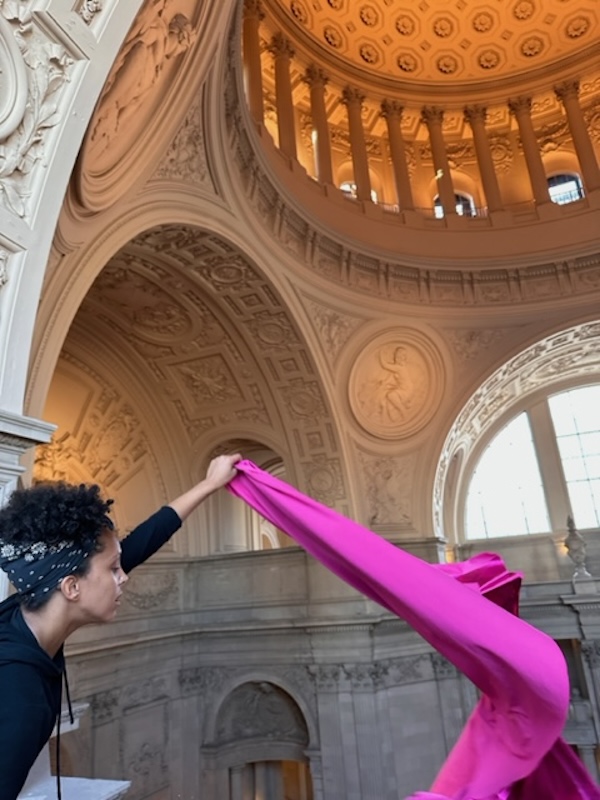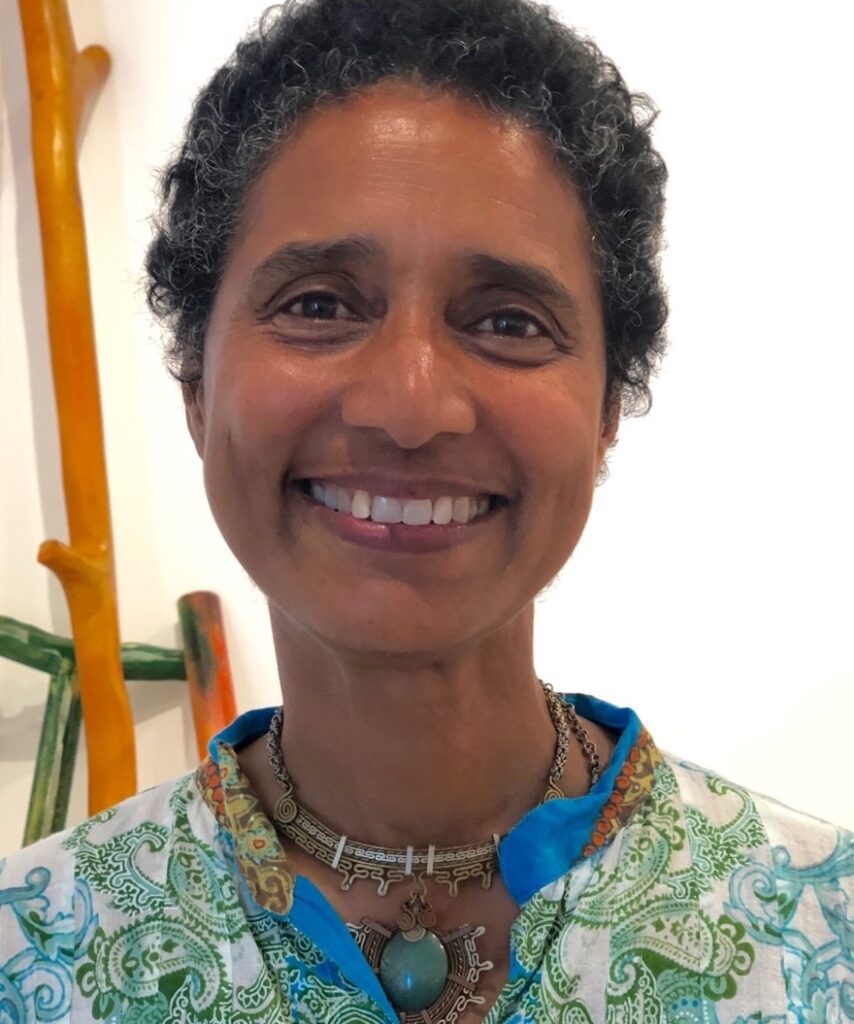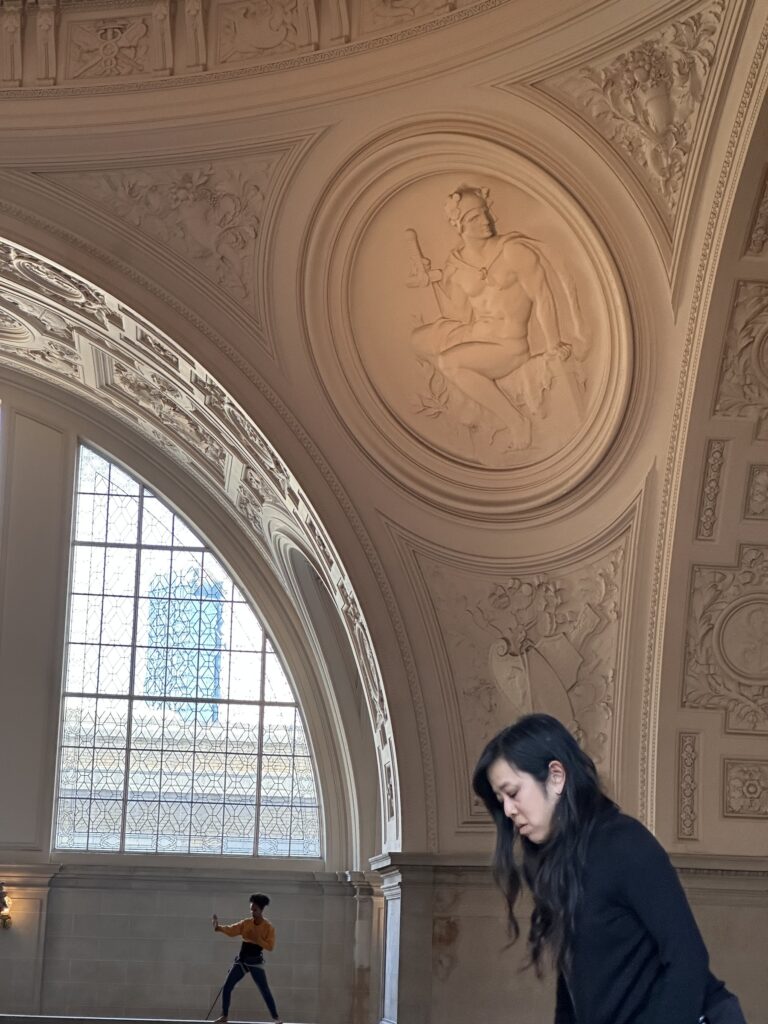Zaccho Dance Theatre choreographer Joanna Haigood’s work is site specific on a grand scale, often with an array of terrestrial and aerial performance elements like swings, ropes, hoops, ladders, zip-lines, soundscapes, video installations. That makes it difficult, and also exciting, to anticipate what a work will look like or even how to watch it. From a theater seat? Walking along a public hiking trail? Lying on the hard marble floor of a cathedral looking up?
I’ve seen numerous Zaccho works over the years, including the iconic Dance for Yal (1987), Invisible Wings (1998), Ghost Architecture (2004), and Love, a state of grace (2022). Yet with each viewing, I marvel at the depth Haigood is able to achieve with her vastly different, prismatic and risk-taking projects. I am always left with an affirmation of what is humanly possible, and of what a place or space can be.
So I am equal parts expectant and without presumptions about The People’s Palace (Thu/9-Sun/12), Haigood’s forthcoming performance installation and artistic intervention inside San Francisco’s City Hall. According to Haigood, and co-producer Wayne Hazzard of Dancers’ Group, over three days aerialists and performers will interact with the Greek and Roman iconography and Beaux Arts architecture, transforming these symbols into new, more inclusive narratives that more accurately reflect San Francisco’s diverse and dynamic cultures and community. Admission for this limited engagement is free. The performance installation is on a 30-minute loop with five timed entries performed per day, 8pm to 10:30pm. Capacity is limited and some entries are already sold out.
Among the team of collaborators are composer Marcus Shelby and visual artist Mildred Howard, scenic designer Sean Riley, rigging designer David Freitag, design consultant and fabricator Wayne Campbell, lighting designer Krissy Kenny, projection designer Aron Altmark, costume designer Dana Kawano, and Indigenous Culture Bearers Gregg Castro and Jonathan Cordero. Hazzard explains, “Site specific projects are never the same in regard to what resources it will take to create in a non-performance setting. This work includes myriad specialists, folks like riggers, fabricators, and media designers, and the creation of new set pieces that will be placed inside City Hall. All of this has to be done without any disruption of the historic space.”

The People’s Palace is a labor of love finally being brought to fruition since its conception four years ago, interrupted by the pandemic and predictably tempered by the constraints of producing a large-scale performance experience in a heavily used civic building.
Destroyed in the Great Earthquake and Fire of 1906 San Francisco City Hall was rebuilt in time for the start of the World’s Fair of 1915 in the Beaux Arts style popular at the time. Dubbed the People’s Palace by then mayor “Sunny Jim” Rolph, the building features gilt exterior detailing, a sweeping grand staircase, and a massive 307 foot high dome, which is a full 42 feet taller than the dome of the nation’s capital. Having endured significant tragedies (such as the murders of Mayor Moscone and Supervisor Milk in 1978) as well as joyful celebrations like hundreds of marriages annually (including, famously, that of Marilyn Monroe and Joe DiMaggio in 1954), SF City Hall remains an important centerpiece of San Francisco life.
Asked what is her process of making a work like The People’s Palace, Haigood responded, “This is a big question. My process changes from project to project. I’ve worked in many different types of environments, with insects and horses, in water and while negotiating traffic. It’s never really the same. Every project requires new skills and a process that makes sense for the situation. The things that remain the same are spending a lot of time at the site, research, being in conversations with others and being present.”
Haigood and Hazzard recalled that Zaccho was the first company to perform at City Hall in 2010 as part of Dancers’ Group’s first Rotunda Series, which for 10 years brought many of the Bay Area’s most celebrated dance companies to San Francisco City Hall for free monthly noon-time performances. Since then, Haigood says, “I’ve been struck by the lack of diversity present in the iconography and in the statuary around the building. When thinking about how or where to focus for this project and as the public discourse around the meaning and significance of public statutes has grown and deepened, particularly around race, I’ve become increasingly interested in how racial bias has historically impacted architectural design.”
Indeed there is local and national attention on public art and architecture, as many communities grapple with representations that often memorialize racist figures and events. Donald Trump’s 2020 executive order further charged the issue in his attempt to standardize new structures in Washington, DC2 with classical architecture. Trump’s order in part reads, “Thomas Jefferson consciously modeled the most important buildings in Washington, DC, on the classical architecture of ancient Athens and Rome. They sought to use classical architecture to visually connect our contemporary Republic with the antecedents of democracy in classical antiquity, reminding citizens not only of their rights but also their responsibilities in maintaining and perpetuating its institutions.”

Haigood said, “Naturally this was very controversial and sparked dialogue and protest from many architectural scholars and institutions.” She cites The Architecture Lobby’s response to the Trump order: “Neoclassicism in the US is directly related to the construction of whiteness. It was whiteness that was sought after in the many plantation houses that chose the style, justifying it as an emulation of ancient Greek ‘culture’ to separate themselves from the Indigenous peoples whose land was stolen and the enslaved African people forced to build and work in them. Thomas Jefferson’s excitement with the work of the Beaux Arts school in Paris was motivated by a desire to make America ‘European’ and ‘white.’”’
Haigood said she started following the work of historians and scholars who are researching the impact of race on architecture design, particularly Irene Cheng, Charles L. Davis II, and Mabel O. Wilson, whose co-edited book Race and Modern Architecture has been an important resource. She explains, “In becoming aware of how architectural design can implicitly and explicitly enforce the invisibility of minority populations, I realized my own struggle to find a sense of belonging in this civic building where very few people of color are represented in the design.”
Haigood said she spent the first year thinking, reading, interviewing historians, and wandering around the building. The second year was spent entirely on meeting the requirements for the permit to do the project as the demands for the engineering documentation were extensive and finding the funding for all the hidden costs was a challenge. “We were delayed several times by additional requirements, right when we thought we were clear,” she says. “This is not completely unfamiliar territory for me and the team of collaborators I work with, but we had a few more hoops to jump through than usual. That said, the design of this show is out of the ordinary for City Hall. I am grateful for the staff’s willingness to recognize and facilitate this vision. It was a big stretch for all of us.”

Another major constraint of public works like these is access to the performance space. The artists only have access to the building when it is open to the public and the rotunda is generally full during the day with weddings, photo shoots and tourists.
“There is often a wonderful parade of costumes, which oddly enough has been helpful in designing this piece,” said Haigood, adding, “It is difficult to build anything on site. People are always in the way and the aerial elements won’t be operational until our installation the week of the show. We only have three days to install the piece and put all the elements together. So there is a lot of drawing, imagining, and praying that everything will work together seamlessly. Nevertheless, I do have great confidence in the ideas and in the brilliant work of everyone involved in this project. I know that whatever happens, it will be powerful.” The performing artists are Veronica Blair, Ciarra D’Onofrio, William Fowler, Jr., Nina Sawant, Saharla Vetsch, Tristan Ching Hartman, Jocelyn Reyes, and The Skywatchers Ensemble.
Haigood refers to The People’s Palace as “an artistic intervention of sorts, with the intention to insert narratives that are excluded from representation, a way to provide a more accurate picture of who and what defines San Francisco.” She explains she doesn’t intend for the piece to be a dismissal of the integrity or the value of the building’s historical architecture.
“It is indeed a brilliant example of the Beaux Arts style and an artistic and engineering marvel,” she said. “Furthermore, it is deeply admired and cherished by the people of San Francisco. I want this piece to feel more like a celebration of the City’s diverse and vibrant community and its legacy of and commitment to thriving together in this extraordinary landscape. I also want it to be a catalyst for dialogue surrounding how to reimagine our public spaces in a way that truly reflects who we are.”
THE PEOPLE’S PALACE runs Thu/9—Sun/12 (haptic tour and audio description is available Fri/10 at 7pm) at City Hall, SF. For reservations and information, click here.




